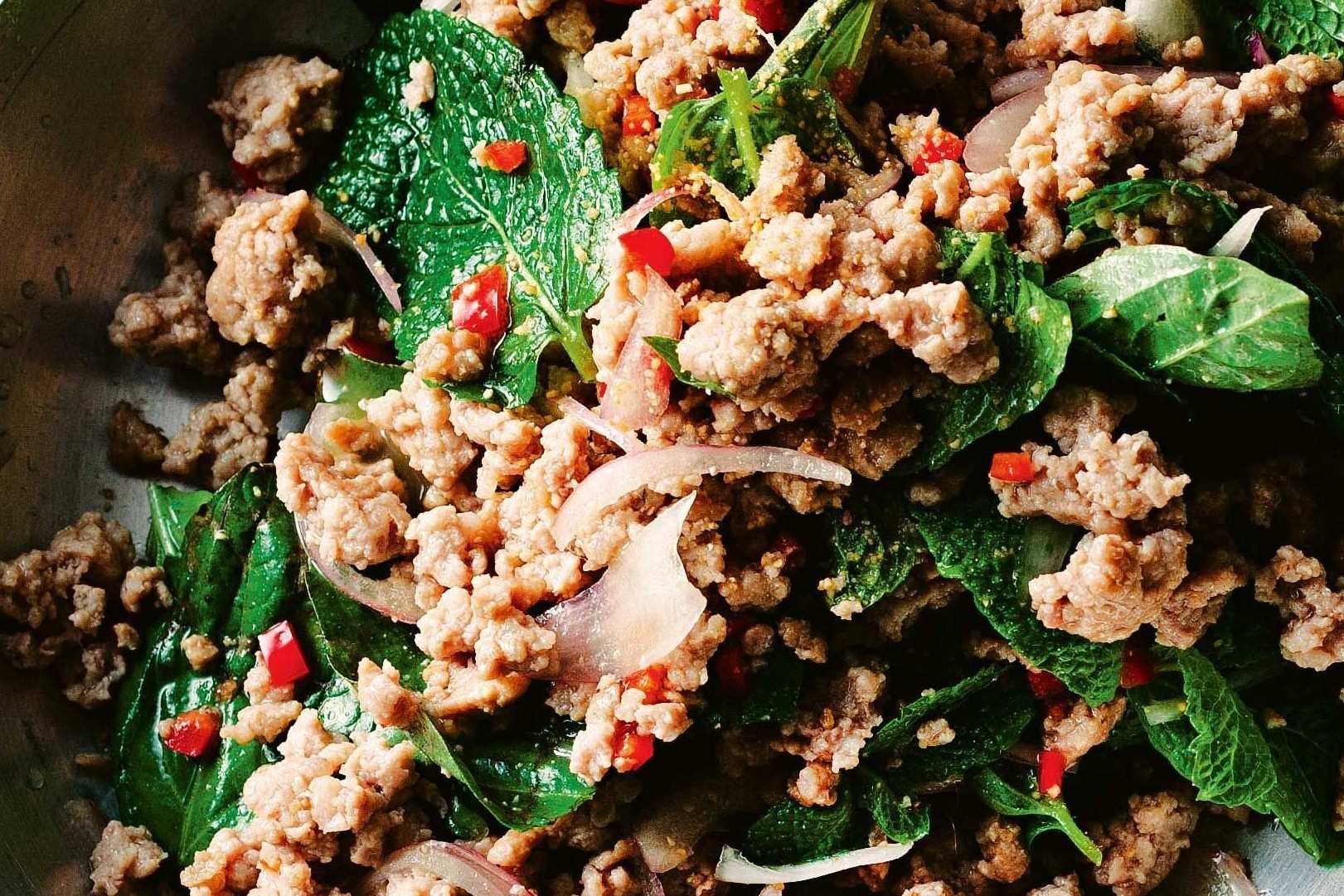This Thai pork mince recipe is a delightful blend of savory and spicy flavors, perfect for a quick weeknight dinner. The combination of pork mince, aromatic garlic, and fresh basil leaves creates a dish that's both comforting and exciting. Serve it over steamed rice for a complete meal that will satisfy your taste buds.
Some ingredients in this recipe might not be staples in your pantry. Fish sauce and oyster sauce are essential for achieving the authentic Thai flavor, so make sure to pick these up at the supermarket. Fresh basil leaves are also crucial for the dish's aromatic finish. If you can't find Thai basil, regular basil will work as a substitute.

Ingredients For Thai Pork Mince Recipe
Pork mince: Ground pork that forms the base of the dish, providing a rich and savory flavor.
Onion: Adds sweetness and depth to the dish when cooked.
Garlic: Provides a pungent, aromatic flavor that enhances the overall taste.
Red chili: Adds a spicy kick to the dish; adjust the amount based on your heat preference.
Soy sauce: Contributes a salty, umami flavor that balances the dish.
Fish sauce: Adds a unique, salty depth that is characteristic of Thai cuisine.
Oyster sauce: Brings a slightly sweet and savory flavor, enriching the dish.
Sugar: Balances the salty and spicy elements with a touch of sweetness.
Basil leaves: Fresh basil leaves add an aromatic, slightly peppery finish to the dish.
Technique Tip for This Recipe
When cooking the pork mince, ensure you break it up into small pieces using a wooden spoon or spatula. This helps the meat cook evenly and allows it to absorb the flavors of the soy sauce, fish sauce, and oyster sauce more effectively. Additionally, adding the basil leaves at the end preserves their fresh, aromatic quality, enhancing the overall dish.
Suggested Side Dishes
Alternative Ingredients
pork mince - Substitute with chicken mince: Chicken mince is a leaner option and absorbs flavors well, making it a suitable alternative.
pork mince - Substitute with beef mince: Beef mince provides a richer flavor and can be used if you prefer red meat.
diced onion - Substitute with shallots: Shallots have a milder and sweeter taste, which can add a subtle complexity to the dish.
diced onion - Substitute with leeks: Leeks offer a delicate onion flavor and can be used for a slightly different texture.
minced garlic - Substitute with garlic powder: Garlic powder can be used in a pinch, though it lacks the fresh, pungent flavor of minced garlic.
minced garlic - Substitute with shallots: Shallots can provide a similar aromatic quality if garlic is unavailable.
sliced red chili - Substitute with crushed red pepper flakes: Crushed red pepper flakes can add the necessary heat and are readily available.
sliced red chili - Substitute with jalapeño: Jalapeños offer a similar level of heat and can be used if red chilies are not available.
soy sauce - Substitute with tamari: Tamari is a gluten-free alternative that provides a similar umami flavor.
soy sauce - Substitute with coconut aminos: Coconut aminos are a soy-free option with a slightly sweeter taste.
fish sauce - Substitute with soy sauce: Soy sauce can mimic the salty and umami qualities of fish sauce, though it lacks the fishy undertone.
fish sauce - Substitute with Worcestershire sauce: Worcestershire sauce can provide a similar depth of flavor, though it is less salty.
oyster sauce - Substitute with hoisin sauce: Hoisin sauce is sweeter but can provide a similar thick and rich consistency.
oyster sauce - Substitute with mushroom sauce: Mushroom sauce offers a similar umami flavor and is a good vegetarian alternative.
sugar - Substitute with honey: Honey can add sweetness and a slight floral note to the dish.
sugar - Substitute with maple syrup: Maple syrup provides a natural sweetness and a hint of caramel flavor.
basil leaves - Substitute with mint leaves: Mint leaves offer a fresh and aromatic quality that complements the dish.
basil leaves - Substitute with cilantro: Cilantro provides a different but equally fresh and vibrant flavor.
Other Alternative Recipes Similar to This Dish
How to Store or Freeze This Dish
- Allow the pork mince to cool completely before storing. This helps prevent condensation, which can lead to sogginess and spoilage.
- Transfer the cooled pork mince into an airtight container. Ensure the container is clean and dry to maintain the dish's freshness.
- Label the container with the date of preparation. This helps keep track of how long the pork mince has been stored.
- Store the container in the refrigerator if you plan to consume the dish within 3-4 days. This keeps the pork mince fresh and safe to eat.
- For longer storage, place the airtight container in the freezer. The pork mince can be frozen for up to 2-3 months without losing its flavor and texture.
- When ready to reheat, thaw the pork mince in the refrigerator overnight. This ensures even thawing and maintains the dish's quality.
- Reheat the pork mince in a wok or pan over medium heat until it is thoroughly heated. Stir occasionally to ensure even heating.
- If reheating from frozen, you can also use a microwave. Place the pork mince in a microwave-safe dish, cover it loosely, and heat on medium power, stirring occasionally until hot.
- Add a splash of soy sauce or fish sauce during reheating to refresh the flavors. This can help revive the dish and make it taste as good as freshly cooked.
- Serve the reheated pork mince hot, garnished with fresh basil leaves if desired. This adds a burst of freshness and enhances the dish's aroma.
How to Reheat Leftovers
Stovetop Method:
- Place a non-stick pan over medium heat.
- Add a small amount of olive oil to the pan.
- Add the leftover Thai pork mince to the pan.
- Stir occasionally to ensure even heating.
- Cook for about 5-7 minutes or until the pork mince is thoroughly heated.
- Add a splash of water or chicken broth if the mixture seems dry.
Microwave Method:
- Place the leftover Thai pork mince in a microwave-safe dish.
- Cover the dish with a microwave-safe lid or plastic wrap with a few holes poked in it.
- Microwave on high for 1-2 minutes.
- Stir the pork mince to ensure even heating.
- Continue microwaving in 30-second intervals until the pork mince is hot throughout.
Oven Method:
- Preheat your oven to 180°C (350°F).
- Place the leftover Thai pork mince in an oven-safe dish.
- Cover the dish with aluminum foil to prevent drying out.
- Bake for about 15-20 minutes or until the pork mince is heated through.
- Stir halfway through the reheating process for even warming.
Steaming Method:
- Set up a steamer basket over a pot of simmering water.
- Place the leftover Thai pork mince in a heatproof dish and place it in the steamer basket.
- Cover and steam for about 5-10 minutes or until the pork mince is thoroughly heated.
- Stir occasionally to ensure even heating.
Sous Vide Method:
- Place the leftover Thai pork mince in a vacuum-sealed bag or a ziplock bag using the water displacement method.
- Set your sous vide machine to 60°C (140°F).
- Submerge the bag in the water bath and let it heat for about 30 minutes.
- Remove from the bag and serve hot.
Best Tools for This Recipe
Wok: A large, round-bottomed cooking vessel ideal for stir-frying and cooking at high heat.
Spatula: A flat, broad tool used for flipping and stirring ingredients in the wok.
Knife: Essential for dicing the onion, mincing the garlic, and slicing the red chili.
Cutting board: A surface used to safely chop and prepare ingredients.
Measuring spoons: Used to accurately measure the soy sauce, fish sauce, oyster sauce, and sugar.
Mixing bowl: Useful for holding prepped ingredients before they are added to the wok.
Serving dish: A dish to present the finished Thai pork mince once it’s cooked.
Tongs: Handy for stirring and mixing the basil leaves into the cooked pork mince.
How to Save Time on This Recipe
Pre-chop ingredients: Dice the onion, mince the garlic, and slice the red chili in advance to streamline the cooking process.
Use pre-made sauces: Opt for ready-made soy sauce, fish sauce, and oyster sauce to save time on measuring and mixing.
Cook in batches: If doubling the recipe, cook the pork mince in batches to ensure even browning and faster cooking.
Prep basil leaves: Wash and dry the basil leaves ahead of time, so they are ready to be added at the end.
One-pan method: Use a large wok to cook everything in one go, reducing cleanup time.

Thai Pork Mince Recipe
Ingredients
Main Ingredients
- 500 g Pork Mince
- 1 Onion diced
- 2 cloves Garlic minced
- 1 Red Chili sliced
- 2 tablespoon Soy Sauce
- 1 tablespoon Fish Sauce
- 1 tablespoon Oyster Sauce
- 1 teaspoon Sugar
- 1 cup Basil Leaves
Instructions
- Heat a wok over medium-high heat.
- Add the pork mince and cook until browned.
- Add the onion, garlic, and chili. Cook for another 3-4 minutes.
- Stir in the soy sauce, fish sauce, oyster sauce, and sugar. Cook for another 2 minutes.
- Remove from heat and stir in the basil leaves. Serve hot.
Nutritional Value
Keywords
Suggested Appetizers and Desserts for This Dish
More Amazing Recipes to Try 🙂
- Thai Coconut Fish Curry Recipe35 Minutes
- Thai Pork Tenderloin Recipe40 Minutes
- Vegan Thai Curry Recipe45 Minutes
- Thai Tom Yum Soup Recipe35 Minutes
- Thai Rice Balls Recipe30 Minutes
- Thai Pandan Recipe45 Minutes
- Kabocha Stir Fry Recipe35 Minutes
- Thai Chicken Skewers Name Recipe35 Minutes

Leave a Reply